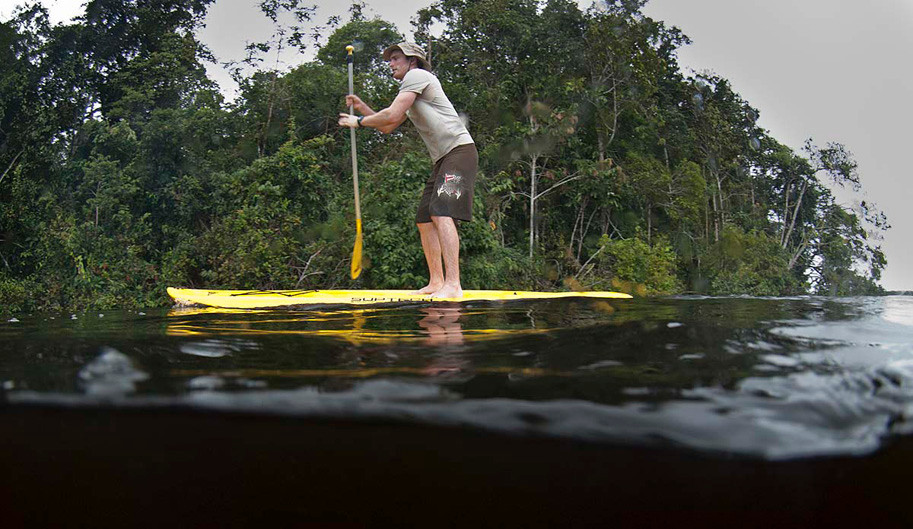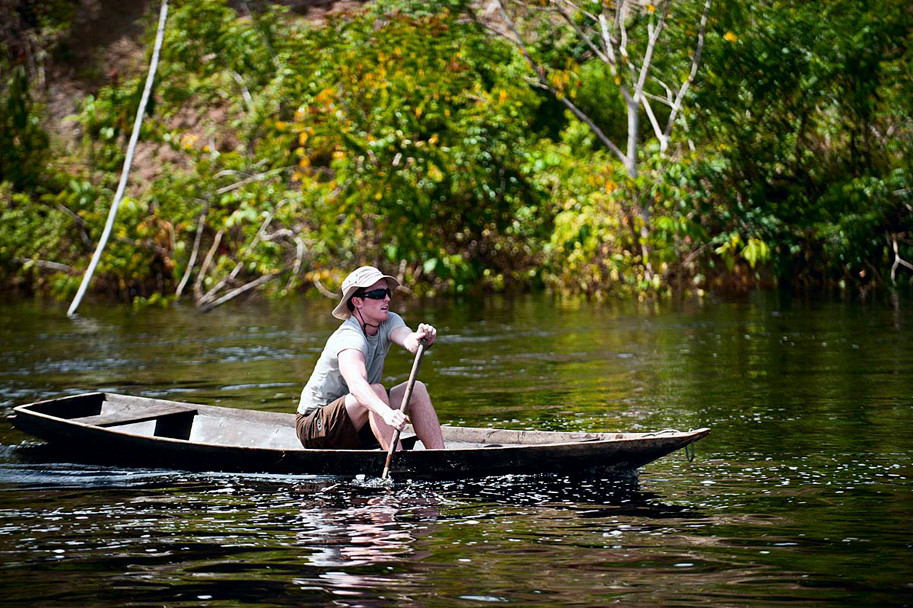Tim White's Amazon adventure
Baldwin resident and 2008 BHS grad Tim White recently returned from a remarkable adventure in the Amazon rainforest. White, 21, who will complete his studies at UCLA later this year, earned his slot on the expedition by participating in a prestigious and highly competitive “selection camp” held in Switzerland. During the selection process, 18 hopefuls vied for eight spots on a research exploration hosted by Mike Horn, founder of the Young Explorers Program. In an essay for the Herald, White describes claiming his berth, and the expedition to the Amazon.
Dear Baldwin:
Last December, I was overjoyed to learn that I was one of 18 lucky people from around the world chosen to participate in a “selection camp” for an expedition through the Amazon rain forest. Now I am excited to share even better news: I was selected for the expedition and have already completed my month-long journey.
These life-changing experiences were made possible by the legendary explorer Mike Horn, a man who has already circumnavigated the globe, swum the length of the Amazon River and even walked to the North Pole. As founder of the Young Explorers Program, Horn has given people from around the world a chance to explore Earth’s most remote and beautiful regions so that they can truly understand how important it is to
protect these natural areas.
Claiming a spot
In late January I flew to Switzerland, where I underwent the most mentally and physically challenging experience of my life. We began each day by completing grueling exercises before the sun had risen over the frozen Swiss peaks. The Mike Horn team was very creative with their exercise routines, challenging us with tasks ranging from 100-yard sprints over frozen fields to long-distance runs up snowy mountains while carrying truck tires.
Morning exercises were followed by a variety of educational presentations designed to prepare us for the Amazon expedition. We learned all about wilderness first aid, backcountry navigation and the environmental problems currently threatening the Amazon areas.
Several days into the selection camp, we were told we would be climbing Les Diablerets, an 11,000-foot glacier also known as Devil’s Glacier. This proved to be one of the toughest days of the camp, as we had to fight through -35 degree temperatures and 40-mph winds. It was so cold that our insulated thermoses of hot chocolate froze before we reached the summit. But after hours of climbing, we were rewarded with one of the most incredible views I have ever seen.
Although climbing Devil’s Glacier was difficult, the most challenging part of the selection camp was definitely “the raid.” The raid is a 25-mile off-road race that takes over 24 hours to complete and brings participants to the peaks of several mountains. We were split into two teams and given the GPS coordinates of 12 checkpoints, a map and a compass that we used to find our way through the snowy Swiss forests. At each checkpoint we completed challenges that ranged from ice-climbing frozen waterfalls to icy obstacle courses. After we finished 15 miles, we were given a 4-foot truck tire that we had to carry for the rest of the race. This was especially difficult when we were hiking through three feet of snow up a mountain.
Shortly after the raid, we learned who was selected for the Amazon expedition. I was one of the lucky eight. I was so excited when I got the news that I literally jumped out of the chair I was sitting in. As overjoyed as I was, however, the feeling was bittersweet when I thought of all the friends I’d made who wouldn’t be joining the expedition. When I’d arrived in Switzerland, my only thoughts were of exploring the Amazon. I didn’t realized that the selection camp itself would become one of the most memorable and enjoyable experiences of my life.
Heading upriver
In early March, we flew to South America, where we met Horn aboard Pangaea, the 115-foot sailboat that he uses to explore the world. Although many of us had never sailed, I quickly understood how much trust would be placed in us and how quickly we had to learn the ways of the boat: On our very first night aboard, Mike dived into the surging Amazon River in the middle of the night and relied on us to “rescue” him. Once he was safely back aboard, all of us Young Explorers dived in, and he “rescued” us. This powerful experience set the tone for the rest of the expedition.
Within several days we were responsible for piloting the craft upriver while avoiding sandbanks and giant submerged trees. We often took turns sailing throughout the night so we could cover more distance. It takes a special kind of focus for a rookie sailor to pilot a boat in the dark, believe me.
Mike taught us how important it is to truly feel everything you do in life. We learned that our bodies could feel slight changes in wind direction or in the boat’s heading that no instruments could have detected. It was a very empowering feeling to take the helm of a massive craft and know that you are responsible for the safety of everyone aboard.
Each day, we left the sailboat to explore the jungle, to experience traditional Amazon village life or to do some environmental work. As Mike led us through the jungle, he taught us how to survive in the wild by fishing for piranha or making traps and snares out of local plants. He showed us how to avoid venomous snakes and hungry jaguars, and we learned how to navigate the rain forest, where swamps and dense foliage made each and every step a battle.
By the end of the expedition, Mike was confident enough to allow us to lead the way through the jungle. Along the trail we saw wild boars, giant tarantulas and caiman, relatives of crocodiles that can grow to be 12 feet long.
We had many adventures in the river itself. We snorkeled through flooded forests while sharing the water with piranha, poisonous snakes and caiman. (We were fortunate that none of those creatures ever bothered us.) We also explored parts of the river using paddleboards and pirogues — wooden canoes hand-crafted by local Amazonians.
It may seem counterintuitive, but clean drinking water can be scarce in the Amazon region, since it isn’t safe to drink directly from the river. Throughout the expedition, we worked to combat this problem. We frequently stopped at tiny communities along the river that consisted of hand-built, wooden homes. When we learned that a village lacked an adequate freshwater supply, we provided them with water filters that remove harmful germs.
The adventure continues
Although the expedition is now complete, I’m going to stay involved with Horn and the Young Explorers Program. The community of Young Explorers initiates environmental projects across the world, so I’m excited about helping to protect not only the inspiring places I’ve seen, but our local wonders as well. There are still many opportunities for adventure, environmental work and exploration. Check out MikeHorn.com to learn how you can get involved.

 57.0°,
Mostly Cloudy
57.0°,
Mostly Cloudy 













